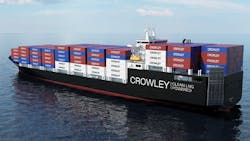Even Landlubbing Shippers must Navigate around Icebergs
Ocean carriage is an industry for long-term planners. That impression was delivered loud and strong recently with two separate announcements from two separate ocean carriers. Interestingly, the two announcements came on the same day: November 25th.
The first came from Evergreen Line, which announced that the time is finally right to renew its fleet of ships. What was particularly interesting about this announcement was that it gave as much importance to the company’s previous decision NOT to renew its fleet as it gives to its new go-time message.
The announcement opens with a little history. Back in 2006, it states, Dr. Chang, Evergreen Group Chairman, cautioned competitors against a market downturn. Chang predicted that the continuous ordering of large vessels among those competitors would lead to a rapid increase in capacity and thus a market crisis in his industry. Apparently Evergreen was guided by this wisdom as far back as July 2003, when the company signed its last contract to build 10 new ships. They wouldn’t enter another such agreement until July 2010, and customers wouldn’t see new capacity until the first half of 2012.
The rival announcement we saw the same day this one came out was from Crowley Holdings, not only making news by announcing plans for new capacity, but adding environmental sustainability to the mix. It stated that larger, faster and environmentally-friendly liquefied natural gas (LNG)-powered, combination container – Roll-On/Roll-Off (ConRo) ships would be providing services between the United States mainland and Puerto Rico in time for the second and fourth quarters of 2017. These will replace Crowley’s towed triple-deck barge fleet.
Well, in uncertain times, this industry makes news the same way its ships navigate the sea’s uncertain currents: by exercising robust steering control. One text on sea navigation characterizes the importance of such techniques as “potentially reducing the effects of external conditions and minimizing path deviations in case particularly strong lateral wind or wave forces are experienced.”
That characterizes the strategy of managers in the ocean carriage industry these days. Declining volume and over-capacity have forced competitors to be cooperators. Earlier this year Mediterranean Shipping Company, Maersk Line and CMA CGM agreed to an arrangement called the P3 Network that will operate a capacity of 2.6 million TEUs (255 vessels initially) on three trade lanes: Asia-Europe, Trans-Pacific and Trans-Atlantic. It is said this and other such alliances in the industry will ensure more stable, frequent and flexible services.
Shippers will benefit from the energy ocean carriers are expending to fill capacity, but they should also be taking notes—especially those shippers who must still use truckload services instead of drones. Capacity in that space will be shrinking as drivers become scarce and carriers struggle to fill service voids. Shippers can help fill those voids themselves by shifting over to intermodal rail. But just as ocean carriers must build more time into their course adjustments, shippers should be equally deliberate in their shift to rail. As David Sparkman writes in an article to appear in MH&L’s upcoming December issue, shippers can enjoy better pricing by going intermodal, but they’ll have to plan for longer transit times. That means being smarter about how much safety stock you carry and making the necessary arrangements to carry a little bit more inventory.
The message from all this is that whether you ship by water, land or drone, you should always be prepared for challenges and sea changes in all of them.
About the Author
Tom Andel Blog
former Editor-in-Chief
As editor-in-chief from 2010-2014, Tom Andel oversaw the strategic development of MH&L and MHLnews.com, bringing 30+ years of thought leadership and award winning coverage of supply chain, manufacturing logistics and material handling. Throughout his career he also served in various editorial capacities at other industry titles, including Transportation & Distribution, Material Handling Engineering, Material Handling Management (predecessors to MH&L), as well as Logistics Management and Modern Materials Handling. Andel is a three-time finalist in the Jesse H. Neal Business Journalism Awards, the most respected editorial award in B2B trade publishing, and a graduate of Cleveland’s Case Western Reserve University.



